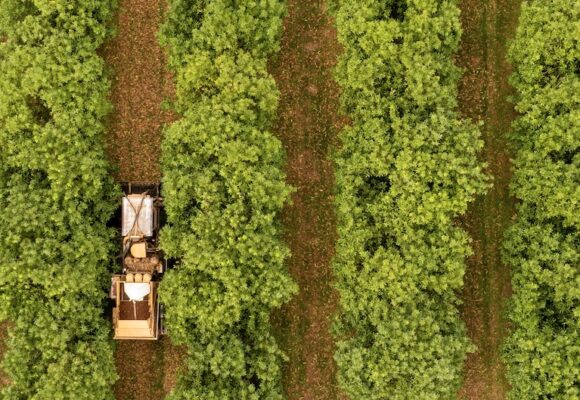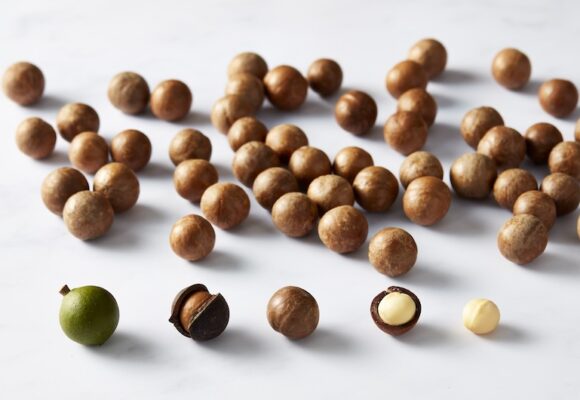In 2016, the Bundaberg region became the highest producing macadamia region in Australia, producing 19,900 tonnes of nut in shell (3.5% moisture), and growing almost five-fold since 2000.

Bundaberg region macadamia industry at a glance:
Trees planted: 2,200,000
Total area under canopy: 6,800 hectares
Total growers: 75 (approx.)
Total production: 19,900 tonnes nut in shell @ 3.5% moisture (2016)

Pioneer perspectives
Lincoln Doggrell has been involved in Bundaberg’s macadamia industry since the 1960s, when he began working as manager of sugar refining giant CSR’s macadamia plantations in Queensland. His area of responsibility stretched from Rockhampton in the north to Beerwah in the south, with Bundaberg in between.
According to Lincoln, the impetus for CSR to enter the macadamia industry in the sixties was the then CEO, Jim Dixon. “Jim saw the macadamia industry the sugar millers were establishing in Hawaii and was determined to start an industry here, with land at Bundaberg being the first area CSR secured, in 1963,” Lincoln said.
This move, along with the work of Norm Greber, who was trying to select worthwhile commercial varieties, set the industry in Bundaberg on its way. A drawback at the time was a ban put in place by CSR management on buying sugar cane land for macadamia production because, as Lincoln puts it, they “did not want to stir troubles with the then Bundaberg Sugar Co. and certainly did not want to cause rumours that CSR was turning away from sugar cane growing.”
Geoff Chivers has been growing macadamias near Bundaberg since 1990. He married Narelle in 1994 and she has been an active partner in the business since. They have seen the industry there expand from that begun by CSR and a few adventurous pioneers (themselves included) to the powerhouse that it is today. From their first plantings in 1990, the Chivers now have 43 hectares with about 14,000 drip-irrigated macadamia trees.
Geoff was living in Melbourne when friends in Bangalow introduced him to macadamias. They had a macadamia tree and would send a sugar bag of macadamia nuts to the Chivers family each year. “I would sit on the back step, cracking the nuts with a hammer, and I think I ate 75% of the macadamias with my family, sharing the remaining 25%” Geoff recalls.
After growing stone fruit and apple crops for five generations in Victoria, Geoff moved to Bundaberg in 1985 and started a trial block of low chill stone fruit. While viable initially, it was labour intensive and profitability dropped as other growers entered the industry. This led Geoff and Narelle to search for alternative crops and to macadamias, which were being planted on a neighbouring property.
“We looked into the economics and while it seemed to be very capital intensive in the early years, we believed that, once established, labour costs would be significantly less than any other tree or vegetable crop, which has proven to be correct. While it has had its ups and downs, the macadamia industry has been incredibly rewarding for us, both financially and in terms of lifestyle,” says Geoff.
Natural assets suited to macadamia production
One of the reasons for Bundaberg’s suitability to growing macadamias is the land itself. Bundaberg is relatively flat and the farms are of a generally regular shape, allowing for long rows. The flat topography has allowed for progressive mechanisation using high capacity, efficient machines, and the semi-dry climate facilitated timely orchard operations.
The Burnett water supply scheme, with over 600 kilometres of pipeline and channels, guarantees irrigation water for production in the driest of seasons, contributing to regular high quality crops.
Along with geographical suitability and irrigation water, a number of other factors have also contributed to the growth of the industry in Bundaberg:
- Free sharing of information through grower forums
- Climate
- Farm size is generally bigger than in the other macadamia growing regions, delivering associated economies of scale
- Initial affordability of fully developed irrigation farms, e.g. sugar cane farms
- Diversity of backgrounds of new entrants into the macadamia industry, leading to growers trialing new and innovative orchard practices
- The region’s extensive mechanical engineering expertise, including a sound understanding of how hydraulic power can be applied to agriculture
Room to grow
Both Geoff and Lincoln are positive that macadamia production in the Bundaberg area will continue to expand as a force in Australian and world macadamia production. Lincoln believes a priority moving forward will be the development of an efficient method of canopy management to deliver continued high yields of high quality nuts.
A definite advantage of the region is its access to irrigation water sources through the Burnett water supply scheme, a key factor that will underpin further growth.
“While a limiting factor is going to be the demand for land from other crops, particularly small crops, which is pushing land prices up, I am confident there will be many more plantings in the Bundaberg region,” Lincoln said.
Geoff agrees and as far as he is concerned, the only way for the industry is up. He sees no reason why farms in the Bundaberg region should not average more than 4 tonnes per hectare in shell, something he said he and Narelle are committed to keep doing by continuously fine-tuning their farm practices.
“Bundaberg has significant potential to expand production, both from existing trees and from newly planted areas. Trees are now being planted in soils that were once considered less than ideal for macadamias, where judicious use of irrigation and fertiliser is seeing less vigorous tree growth but increased kernel production per hectare.
“The IOM (Integrated Orchard Management) and ION (Integrated Orchard Nutrition) programs have shown what can and should be achieved in this and other districts,” he said.
2,500 hectares of macadamias are expected to be planted in the Bundaberg region throughout 2017 and 2018. According to Robbie Commens, Productivity Development Officer for the Australian macadamia industry, professional macadamia growers can be recognised not through orchard size, rather through their mindset of continual improvement with an ongoing commitment to the long term.
“The Bundaberg region is characterised by professional macadamia growers, and this will continue to benefit both the region and the macadamia industry as a whole in the future,” Robbie said. “I have visited a range of macadamia producing regions, including South Africa, Hawaii and Mexico, and I believe the Bundaberg region probably leads the world in macadamia production as far as agronomy, innovation and professionalism are concerned.”
“It is really exciting to see what the future will bring, particularly for mature orchard management innovation,” he said.


